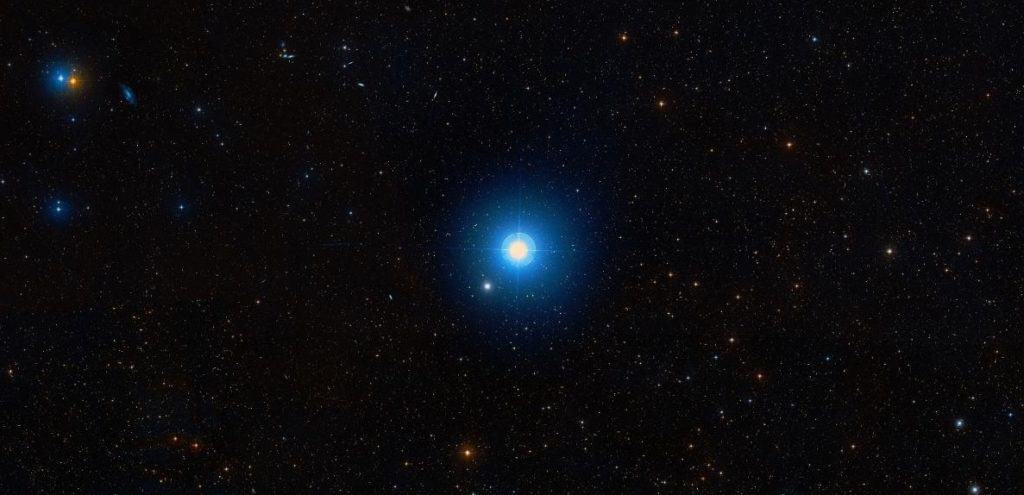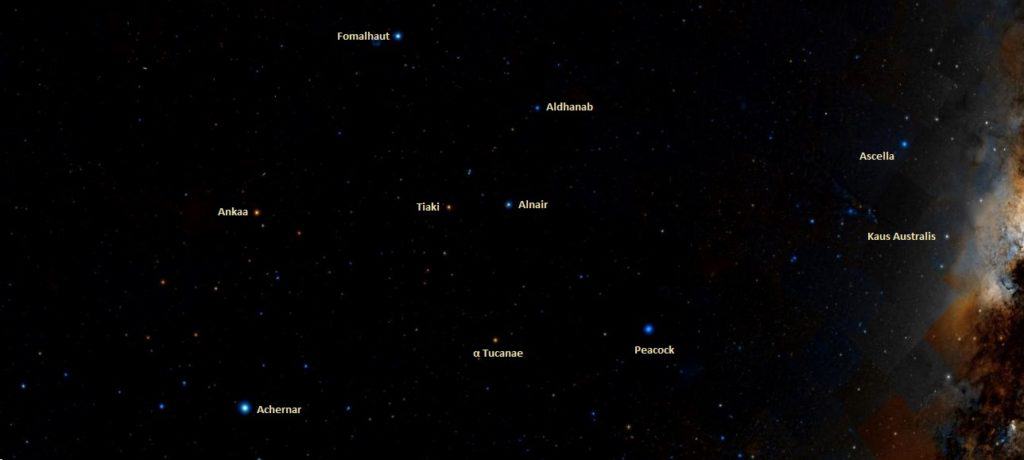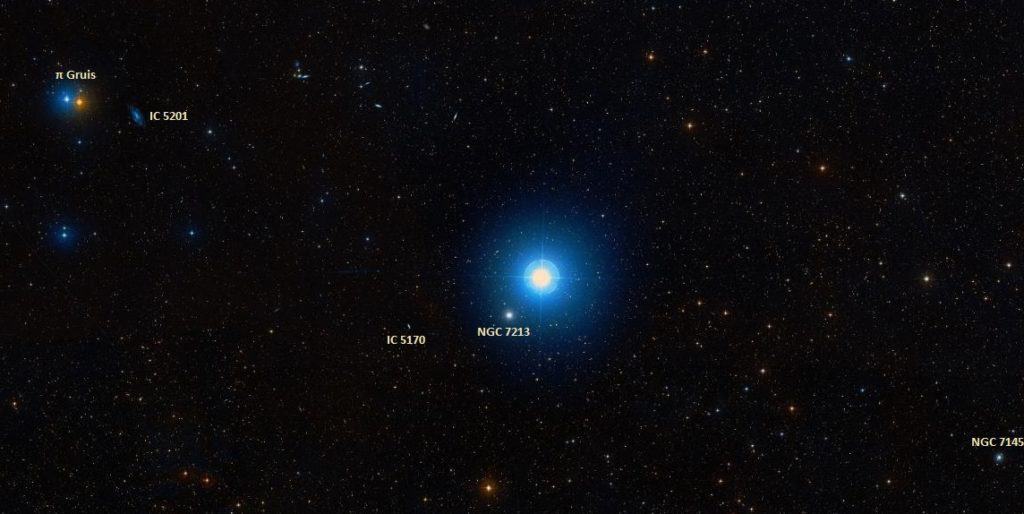Alnair, also known as Alpha Gruis, is the brightest star in the constellation of Grus. It is the 30th brightest star in the night sky. It is the only navigational star in Grus.
Key Facts & Summary
- Alnair is a bluish-white main-sequence star that is around 101 light-years / 31 parsecs away from the Sun.
- It has an apparent magnitude of +1.74 and an absolute magnitude of -0.72.
- Alnair’s spectral type is yet uncertain. Some sources place the star in the B6 V classification, while others place the star in the B7 IV classification.
- Alnair has a mass of around 4 times that of the sun. It is also much bigger.
- Alnair has an estimated 3.4 solar radii. This would indicate that it would have around 6.8 times the sun’s diameter.
- Alnair is much brightest than our sun. It has around 520 solar luminosities.
- The lonely star has average surface temperatures estimated at around 13.920 K.
- Alnair rotates quite fast, its rotational velocity has been estimated to be around 215 km / 133.5 mi per second.
- Our sun is much older than Alnair, the star has been estimated to have just around 100 million years.
- Alnair has a surface gravity of around 3.76 cgs.
- Alnair has the proper age and similar motion to be considered a member of the AB Doradus moving group of stars. The group’s average age is somewhere between 70 to 150 million years old.
- When it comes to the abundance of heavy elements, Alnair has around 74% of the sun’s metallicity.
- Alnair is the only star in its constellation that is part of the 58 stars used for celestial nagivation. Only the brightest stars and the most recognizable stars are part of this group.
- Alnair forms a triangle with Achernar and Fomalhaut.
The origin of Alnair’s name comes from the Arabic language. It translates to “the bright one.” Some variations of the name are Al Nair and Al Na’ir. In comparison to other stars, Alnair is slightly fainter than Bellatrix, Alnilam, Elnath, Miaplacidus, and barely outshines Alnitak, Alioth, Dubhe, and Mirfak.

Many stars from the constellation of Grus, including Alnair, were used in Arabic astronomy as components of the constellation of Piscis Austrinus. The Greek’s didn’t list these stars in their constellation of Picis Austrinus, at least when the Greco-Roman astronomer Ptolemy, listed the star’s in his 2nd century Almagest, they were not part of that constellation.
Formation
Alnair is estimated to have formed around 100 million years ago from a cloud of molecular gas and dust. Gravity pulled the swirling gas and dust togerther to form the star. Alnair’s origin remains attached to the AB Doradus Moving Group – a group of stars that have a common origin, similar age, and motion through space. This group formed in the star-forming region as the Pleiades cluster.
Distance, Size, and Mass
Alnair is around 101 light-years / 31 parsecs away from the Sun. The star has a mass of around 4 times that of the sun. Alnair has an estimated 3.4 solar radii. This would indicate that it would have around 6.8 times the sun’s diameter. It is possible that Alnair is thus around 6 times bigger than our sun.

Other Characteristics
Alnair is a bluish-white main-sequence star with an apparent magnitude of +1.74 and an absolute magnitude of -0.72. Alnair’s spectral type is yet uncertain. Some sources place the star in the B6 V classification, while others place the star in the B7 IV classification.
If it is a B6 V spectral type, then it means that Alnair is still fusing hydrogen at its core. If Alnair is a B7 IV type, then it means that the star has runned out of hydrogen and it has started to move off of the main sequence.

Alnair is much brightest than our sun. It has around 520 solar luminosities. The lonely star has average surface temperatures estimated at around 13.920 K. Thus, it is around 2.4 times hotter than our sun. When it comes to the abundance of heavy elements, Alnair has around 74% of the sun’s metallicity.
Alnair is also rotating quite fast, its rotational velocity has been estimated to be around 215 km / 133.5 mi per second. Its motion through space indicates that it may be part of the AB Doradus Moving Group.
Location
Alnair is located in the constellation of Grus, the celestial crane. This constellation is quite “new.” It first appeared in Johann Bayer’s celestial atlas Uranometria in 1603. It was created in the 16th century based on the observations of Dutch explorers.

There are many interesting objects in this constellation, such as nebulas, galaxies, and other stars. The constellation is high in the evening sky during the month of October, as such, this is the best month to observe the deep sky objects and stars situated there.
Alnair is invisible for observers in most of the northern hemispheres. The star forms a triangle with a brighter star named Achernas, which is situated in the constellation of Eridanus, and Fomalhaut, which is in the constellation of Piscis Austrinus.
Alnair lies in the region of the sky between Fomalhaut and Peacock in the constellation of Pavo. Alnair is also situated near two galaxies – the lenticular galaxy NGC 7213 and the barred spiral galaxy IC 5201.

The Future
Alnair’s future is a bit obscured. If its spectral type will be finally established, we will know exactly what the star’s current path is in regards to its stellar evolution.
Did you know?
- The Chinese knew Alnair as the First Star of the Crane. It was part of an asterism formed by Tiaki, Delta Gruis, Epsilon Gruis, Zeta Gruis, Eta Gruis, Iota Gruis, Theta Gruis, Mu Gruis, and Delta Tucanae which was situated in the closest constellation to Grus, Tucana.
- Confusingly, Alnair was also given the proper name for Zeta Centauri in the middle of the 20th century. This was changed in 2016 by the WGSN.
- If the New Horizons Probe would travel to Alnair at a speed of 33.000 m.p.h., it would reach the star in around 2.052.696.54 years.
- If a car could “fly” towards Alnair at a speed of 120 m.p.m., it would reach the star in around 564.491.547.46 years.
Sources:
Image source:
- https://www.star-facts.com/wp-content/uploads/2019/10/Alnair.jpg?189db0&189db0
- https://osr.org/wp-content/uploads/2016/06/alpha-gruis-star.jpg
- https://www.star-facts.com/wp-content/uploads/2019/10/Alnair-location.jpg
- https://upload.wikimedia.org/wikipedia/commons/thumb/3/31/Grus_IAU.svg/637px-Grus_IAU.svg.png
- https://www.star-facts.com/wp-content/uploads/2019/10/Alnair-NGC-7213-and-IC-5201.jpg?189db0&189db0
